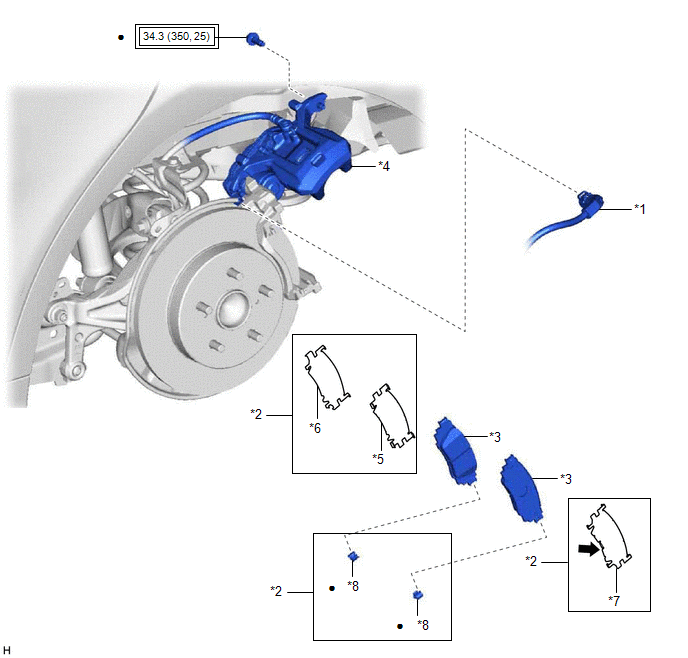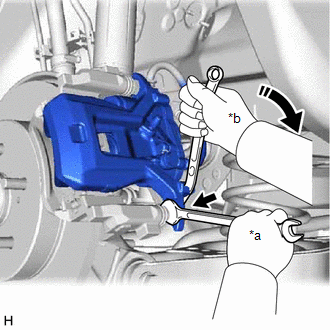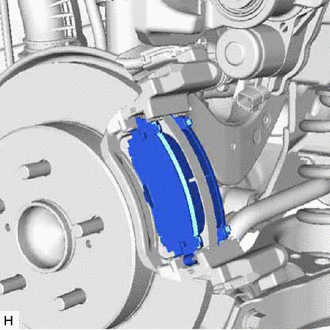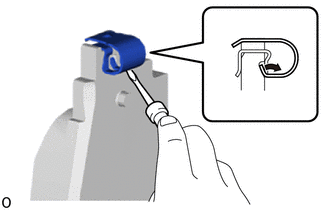Installation
INSTALLATION
CAUTION / NOTICE / HINT
NOTICE:
- Immediately after installing the brake pads, the braking performance may
be reduced. Always perform a road test in a safe place while paying
attention to the surroundings.
- After replacing the rear disc brake pads, the brake pedal may feel soft
due to clearance between the rear disc brake pads and rear disc. Depress
the brake pedal several times until the brake pedal feels firm.
- After replacing the rear disc brake pads, always perform a road test to check the braking performance and check for vibrations.
- When the brake pedal is first depressed after replacing the brake pads
or pushing back the disc brake piston, DTC C1214 may be stored. As there
is no malfunction, clear the DTC. (for HV Model)
- While the auxiliary battery is connected, even if the power switch is
off, the brake control system activates when the brake pedal is
depressed or any door courtesy switch turns on. Therefore, when
servicing the brake system components, do not operate the brake pedal or
open/close the doors while the auxiliary battery is connected. (for HV
Model)
HINT:
- Use the same procedure for the RH side and LH side.
- The following procedure is for the LH side.
PROCEDURE
1. INSTALL REAR DISC BRAKE ANTI-SQUEAL SHIM KIT
NOTICE:
- When replacing worn rear disc brake pads, the rear disc brake
anti-squeal shims and rear disc brake pad wear indicator plates must be
replaced together with the rear disc brake pads.
- Install each rear disc brake pad wear indicator plate in the correct position and direction.
- Install the rear disc brake anti-squeal shims in the correct positions and directions.
- Do not apply disc brake grease to the lining surface of the rear disc brake pad.
| (a) Check the rear disc brake pad.
HINT: If the rear disc brake pad has an identification mark, be sure to confirm the installation location. |
 |
|
*a | Inner Side (White) | |
*b | Outer Side (White) | | |
(b) Apply disc brake grease to the inner side of the rear disc brake anti-squeal shim as shown in the illustration.
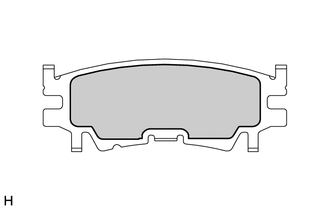
 |
Disc Brake Grease |
| (c) Install the rear No. 1 disc brake anti-squeal shim to the rear disc brake pad (inside). |
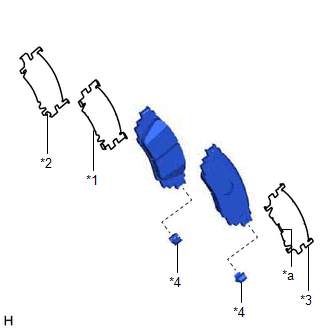 |
|
*1 | Rear No. 1 Disc Brake Anti-squeal Shim | |
*2 | Rear No. 2 Disc Brake Anti-squeal Shim | |
*3 | Rear Disc Brake Anti-squeal Shim | |
*4 | Rear Disc Brake Pad Wear Indicator Plate | |
*a | Claw | | |
(d) Install the rear No. 2 disc brake anti-squeal shim to the rear disc brake pad (inside).
(e) Install the rear disc brake anti-squeal shim to the rear disc brake pad (outside).
NOTICE:
Install the rear disc brake anti-squeal shim so that its claws are toward the outside of the vehicle.
(f) Install a new rear disc brake pad wear indicator plate to each rear disc brake pad.
2. INSTALL REAR DISC BRAKE PAD
CAUTION:
- Be careful not to get pinched by the rear disc brake cylinder assembly or other parts when installing the rear disc brake pads.
- After lifting up the rear disc brake cylinder assembly, secure it in place before performing any work on it.
- The rear disc brake cylinder assembly could fall, pinching hands or fingers and causing injury.
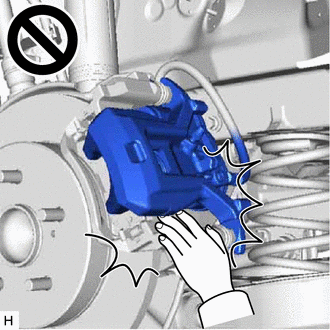
(a) Push in the rear disc brake piston.
NOTICE:
- Make sure the brake fluid does not overflow from the reservoir.
- Do not forcibly push in the rear disc brake piston.
(b) Install the 2 rear disc brake pads to the rear disc brake cylinder mounting.
NOTICE:
- Keep the friction surfaces of the rear disc brake pads and rear disc free from oil and grease.
- Install the rear disc brake pad so that the rear disc brake pad wear
indicator plate is mounted on the lower side of the vehicle.
HINT:
If the rear disc brake pad has an identification mark, be sure to confirm the installation location.
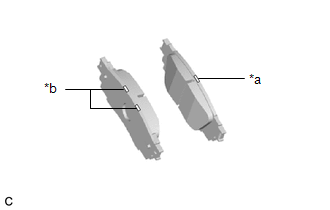
|
*a | Inner Side (White) |
|
*b | Outer Side (White) |
(c)
Hold the rear No. 1 disc brake cylinder slide pin and install the rear
disc brake cylinder assembly to the rear disc brake cylinder mounting
with a new bolt.
Torque:
34.3 N·m {350 kgf·cm, 25 ft·lbf}
(d) Depress the brake pedal several times. (for Gasoline Model)
3. CONNECT NO. 2 PARKING BRAKE WIRE ASSEMBLY
Click here

4. CONNECT CABLE TO NEGATIVE AUXILIARY BATTERY TERMINAL (for HV Model)
(a) Connect the reservoir level switch connector.
(b) Connect the cable to the negative (-) auxiliary battery terminal.
Click here 
(c) Turn the power switch on (READY).
(d) Depress the brake pedal and release it.
(e) Clear the DTCs.
Click here 
5. INSPECT BRAKE FLUID LEVEL IN RESERVOIR
for Gasoline Model: Click here 
for HV Model: Click here

6. INSTALL REAR WHEEL
Click here

7. NORMAL CONDITION RECOVERY
for Gasoline Model: Click here

for HV Model: Click here

Removal
REMOVAL
CAUTION / NOTICE / HINT
The
necessary procedures (adjustment, calibration, initialization, or
registration) that must be performed after parts are removed and
installed, or replaced during rear disc brake pad removal/installation
are shown below.
Necessary Procedures After Parts Removed/Installed/Replaced |
Replaced Part or Performed Procedure |
Necessary Procedure | Effect/Inoperative Function when Necessary Procedure not Performed |
Link |
|
*1: for HV Model
*2: When performing learning using the Techstream. Click here
 |
|
Auxiliary battery terminal is disconnected/reconnected*1 |
Perform steering sensor zero point calibration |
Lane Departure Alert System (w/ Steering Control) |
 |
|
Pre-collision System |
|
Intelligent Clearance Sonar System*2 |
|
Lighting System (for HV Model with Cornering Light) |
|
Memorize steering angle neutral point |
Parking Assist Monitor System |
 |
|
Panoramic View Monitor System |
 |
NOTICE:
- Immediately after installing the brake pads, the braking performance may
be reduced. Always perform a road test in a safe place while paying
attention to the surroundings.
- After replacing the rear disc brake pads, the brake pedal may feel soft
due to clearance between the rear disc brake pads and rear disc. Depress
the brake pedal several times until the brake pedal feels firm.
- After replacing the rear disc brake pads, always perform a road test to check the braking performance and check for vibrations.
- When the brake pedal is first depressed after replacing the brake pads
or pushing back the disc brake piston, DTC C1214 may be stored. As there
is no malfunction, clear the DTC. (for HV Model)
- While the auxiliary battery is connected, even if the power switch is
off, the brake control system activates when the brake pedal is
depressed or any door courtesy switch turns on. Therefore, when
servicing the brake system components, do not operate the brake pedal or
open/close the doors while the auxiliary battery is connected. (for HV
Model)
HINT:
- Use the same procedure for the RH side and LH side.
- The following procedure is for the LH side.
PROCEDURE
1. PRECAUTION (for HV Model)
NOTICE:
- After turning the power switch off, waiting time may be required before
disconnecting the cable from the negative (-) auxiliary battery
terminal. Therefore, make sure to read the disconnecting the cable from
the negative (-) auxiliary battery terminal notices before proceeding
with work.
Click here 
- Make sure to read the precautions of the electric parking brake system before removing the rear brake assembly.
Click here 
2. REMOVE REAR WHEEL
Click here 
3. PERFORM REAR BRAKE PAD REPLACEMENT MODE
for Gasoline Model: Click here

for HV Model: Click here

4. DISABLE BRAKE CONTROL (for HV Model)
Click here 
5. DISCONNECT NO. 2 PARKING BRAKE WIRE ASSEMBLY
Click here 
6. REMOVE REAR DISC BRAKE PAD
CAUTION:
- Be careful not to get pinched by the rear disc brake cylinder assembly or other parts when removing the rear disc brake pads.
- After lifting up the rear disc brake cylinder assembly, secure it in place before performing any work on it.
- The rear disc brake cylinder assembly could fall, pinching hands or fingers and causing injury.
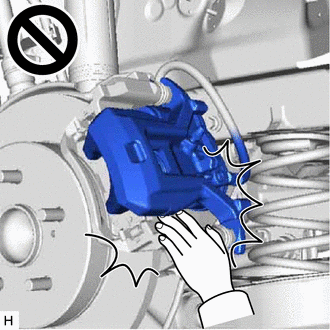
| (a) Hold the rear No. 1 disc brake cylinder slide pin and remove the bolt. |
|
(b) Pull the rear disc brake cylinder assembly upward.
| (c) Remove the 2 rear disc brake pads from the rear disc brake cylinder mounting. |
|
7. REMOVE REAR DISC BRAKE ANTI-SQUEAL SHIM KIT
| (a) Remove the rear No. 2 disc brake anti-squeal shim from the rear disc brake pad (inside). |
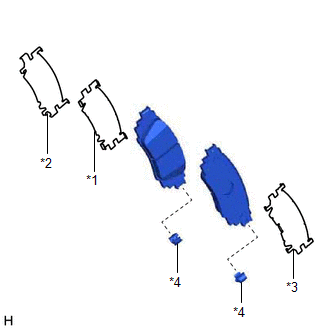 |
|
*1 | Rear No. 1 Disc Brake Anti-squeal Shim | |
*2 | Rear No. 2 Disc Brake Anti-squeal Shim | |
*3 | Rear Disc Brake Anti-squeal Shim | |
*4 | Rear Disc Brake Pad Wear Indicator Plate | | |
(b) Remove the rear No. 1 disc brake anti-squeal shim from the rear disc brake pad (inside).
(c) Remove the rear disc brake anti-squeal shim from the rear disc brake pad (outside).
| (d) Remove the rear disc brake pad wear indicator plate from each rear disc brake pad. |
|
